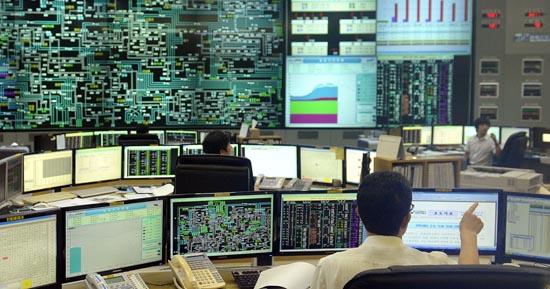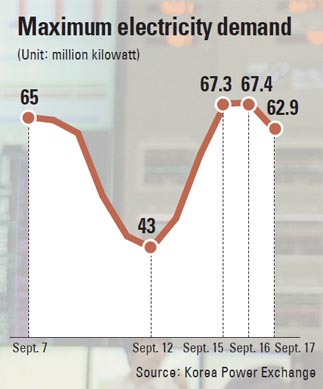Grim minister spreads blame for blackout

Command center employees at the Korea Power Exchange in Samseong-dong, southern Seoul, busy assessing the situation on Thursday when a major blackout occurred throughout the country. [NEWSIS]
The devastating nationwide blackout on Thursday is likely to turn into a bigger problem. According to the minister of knowledge economy, there was a “false” report of available supply.
Before the lights went out, the minister continued, the Korea Power Exchange failed to report the state of emergency and coming suspension of power supplies to authorities in a timely manner. And at the time of the blackout, reserve electricity was much lower than the safe margin of 4 million kilowatts. It was so low that the entire country could have suffered a blackout had the plugs not been pulled in selected areas.
The Ministry of Knowledge Economy, which is in charge of the country’s energy policies, laid out yesterday policies to prevent a similar crisis and said that it would start tomorrow to accept claims for damages caused by the blackout.
The ministry said it would not only raise the electricity supply capacity but also would “adjust” the country’s electricity demand, suggesting the possibility of an additional electricity rate increase down the road to dampen enthusiasm among users. The ministry also said it would upgrade the emergency reporting system at all levels of the government.
In a briefing at the Gwacheon government complex in Gyeonggi, yesterday, Minister of Knowledge Economy Choi Joong-kyung arrived with a grim expression as he explained the origins and repercussions of the problem.
‘False’ reports on reserves

But the figure included 2.02 million kilowatts that could not be supplied immediately. It takes five hours of preheating to produce electricity at power plants, the minister said, but the 2.02 million kilowatts was added to the reserve figure even before preheating began.
“There was a false count in the figure of supply capacity,” Choi said. “There was an incorrect report.”
The corrected report, showing reserves of only 1.4 million kilowatts, came at around 3 p.m., according to Choi.
Making things worse, the actual electricity reserves were even below the 1.4-million-kilowatt figure because of technical considerations in power plant operations during the summer. Not all of that 1.4 million kilowatts could have been thrown into the power grid.
“At the time of the blackout, capacity was overestimated at 70.71 million kilowatts but it was actually 67.52 million kilowatts,” Choi said. “In fact, the reserve electricity was only 240,000 kilowatts.”
With that tiny reserve, he added, Korea may have narrowly avoided a nationwide blackout. As consumption rose, the Korea Electric Power Corporation started suspending electrical service at 3 p.m. In all, 1.6 million households around the country were without power by 6:30 p.m. on Thursday.
Choi said the government is still investigating the cause of the problem but said there were several reporting breakdowns. Kepco and KPX seemingly overlooked the fact that fall temperatures in recent years have been much higher than the long-term average because of global warming.
On Thursday, the temperature peaked at 31.3 degrees Celsius (88.3 Fahrenheit) while the 30-year average is 26 degrees. The ministry told Kepco’s power plants in an Aug. 31 letter that the summer contingency period had been extended to Sept. 23, but a number of plants closed down for maintenance despite the warning. On Thursday, 25 generating stations were idle due to maintenance, a loss of 8.9 million kilowatts.
Choi said he felt responsible for the blackout. “As the minister in charge of electricity demand, I could not respond to it in a timely manner,” Choi said. “I could have asked help from related institutions, including turning off air conditioners at large workplaces and sought cooperation from the public.”

The ministry said it would upgrade its reporting system so that all related officials and employees could be informed of emergencies. It said it would announce in advance the possible suspension of the electricity supply and improve its program to predict demand.
Most importantly, the ministry said, it would change its policy objective to controlling the demand for electricity instead of focusing on its supply. That comment was taken to be a hint of higher electricity prices in the next few years.
The ministry said it would raise the electricity reserve ratio to 14 percent by 2014 by adding 11.45 million kilowatts. The completion of the third and fourth Singori nuclear plants in South Gyeongsang in that year will add the bulk of that additional supply.
Raising electricity rates presents a dilemma to the government. A critical problem is that the electricity rate in Korea has been kept low enough that the public tends to rely on cheap, ample power. Raising the cost of electricity, though, will add to inflationary pressure in the short run.
Cheap electricity has often been blamed for overuse of and soaring demand for energy. The peak level of electricity demand has been rising each year.
According to the ministry, it rose from 62.28 million kilowatts in 2007 to 73.13 million kilowatts this year, a 17.4 percent increase.
Compensation
Choi said the government will start accepting compensation claims tomorrow at 189 Kepco branch offices around the country as well as at the Small and Medium Business Corporation and the Korea Industrial Complex Corporation. Those who want to file claims can call Kepco’s customer service center at 123.
Seoul will also set up a claims compensation committee to handle the claims. It will be made up of consumer organizations, accountants, lawyers and the Korea Federation of Small and Medium Business.
By Limb Jae-un [jbiz91@joongang.co.kr]
한글 관련 기사 [뉴시스]
`정전대란, 왜?`…의혹 풀릴까?
정부, 여론 악화되자 보상방안 등 서둘러 마련
예비력 산정 허위로 드러나…최중경 장관 "허위보고 한 셈"
정부가 사상 초유의 정전대란이 발생한지 불과 사흘 만인 18일 서둘러 재발방지 대책과 보상대책을 내놓았다.
지식경제부는 대규모 정전사고와 관련해 피해를 입은 기업과 국민에 대해 실질적이고 충분한 보상을 해주기로 했다. 또 정전사고와 관련된 책임을 철저히 규명하고 추가로 보완 대책을 강구해 재발방지에도 만전을 기하기로 했다.
물론 이번 대책은 `최종본`이 아닌 `미완성`으로 향후 대책방향을 가늠할 수 있는 수준이다. 그럼에도 지경부가 이처럼 서둘러 중간 대책을 발표한데에는 점점 악화되는 여론을 달래고 정치권 등으로부터 제기되는 책임론을 무시할 수 없었던 것으로 풀이된다. 여기에 시간이 흐를수록 정전대란과 관련된 각종 루머가 하나 둘 씩 생성되며 혼란을 초래하는 상황도 정부엔 심리적 부담으로 작용했을 가능성이 크다.
◇`정전대란` 미완성대책 `急` 발표…여론 달래기?
정전사고 초반만 해도 지경부, 한전, 전력거래소간 책임 떠넘기기식 공방으로 우왕좌왕하던 정부가 서둘러 긴급 대책을 발표한 것은 사안의 심각성을 방증하는 것으로 볼 수 있다.
15일 갑작스런 정전사고는 서울, 인천 등 수도권지역 뿐만 아니라 대구, 광주, 천안, 전주 등 대부분 지방에서도 순차적으로 발생할 만큼 피해규모가 전국적으로 광범위했다. 특히 일반 가정뿐만 아니라 중소기업이 주로 입주한 공단을 비롯해 각 기업과 은행, 대학, 상점 등 경제·사회 등을 망론하고 각 분야에서 단전으로 인한 막대한 손실을 입었다.
이 같은 정부의 정책판단 착오로 일순간 국가 전체의 기능이 마비되다시피 하고 국민들이 큰 충격과 혼란을 겪은 것은 드문 일이었다. 여론이 사상 초유의 인재(人災)라고 분통을 터뜨리는 이유도 이 때문이다.
정부의 업무상 과실은 이상기온과 폭염에 따른 전력수요 예측을 실패한데서 그치지 않았다. 정전사고 후 사태를 수습하는 과정에서도 허점을 노출했다.
정부가 단전을 실시하는 과정에서 전력수급을 관리하는 주무부처 지경부와 한전, 전력거래소간 충분한 논의나 협의없이 결정한 것은 문제라는 지적이다.
정전대란의 가장 큰 영향을 미친 지역별 순환정전 결정을 놓고 전력거래소와 지경부가 선(先)보고 후(後)조치 혹은 후(後)보고 선(先)조치를 주장하면서 눈 꼴 사나운 진실공방을 벌였다. 두 기관의 진실공방을 떠나 국가적인 전력대란에서 정부 내 보고체계는 정상적으로 작동하지 않은 사실이 확인된 셈이다.
또 예비전력량이 감소할 경우 관심(400만㎾ 이하), 주의(300만㎾ 이하), 경계(200만㎾ 이하), 심각(100만㎾ 이하) 등 단계별로 전력수급을 조절토록 돼있지만, 순간 예비력(15일 오후 3시)이 148.9만㎾인 상황에서 강행한 지역별 단전조치는 매뉴얼 준수여부에 대한 논란을 자초했다.
이처럼 정전사태가 천재(天災)가 아닌 인재(人災)란 사실이 속속 드러나면서 급속도로 악화된 여론은 정부가 서둘러 보상과 대책을을 발표하며 진화에 나서는데 영향을 미쳤다.
여야를 막론하고 정치권뿐만 아니라 청와대 내에서도 최중경 장관의 거취를 노골적으로 거론할 만큼 구원(救援)의지가 희박하다는 점도 지경부에 상당한 심리적 압박으로 작용했을 것이라는 관측이다.
특히 진노한 이명박 대통령이 정전사태 다음날 한전을 방문해 "책임을 분명히 따지겠다"며 전력사용량 예측오류로 대규모 전력공급 중단사태를 초래한 지경부, 한전, 전력거래소를 질책하고 대책을 주문한 점도 지경부는 상당히 부담스러웠다는 후문이다.
◇`정전대란` 의혹 풀릴까?
정부가 사태를 급하게 봉합하듯이 서둘러 내놓은 대책의 초점은 크게 정전사태로 인한 피해보상 방안, 책임소재 확인을 위한 조사, 재발방지 대책방향에 중점을 두고 추진된다.
이 가운데 가장 많은 관심을 갖는 부문이 피해보상 유무다. 정부는 피해보상 범위에 대해 정전으로 직접적인 피해를 입은 제조업체, 상가 및 일반 소비자 등으로 제시하면서 개별적으로 피해사실을 조사한 뒤 보상한다는 방안을 내놓았다.
특히 피해보상을 전담하는 기구(피해자보상위원회)를 별도로 설치해 보상문제를 신속히 해결하고, 소비자단체나 중소기업중앙회 등을 위원회에 참여시켜 보상을 최대한 현실화한다는 입장을 밝혔다.
다만 아직 정확한 피해규모가 집계되진 않더라도 정부가 감내할 수 있는 잠정적인 보상금액이나 규모 등을 거론하지 않은 점에서 피해보상이 얼마나 현실화될 수 있을지는 미지수다. 자칫 정부 보상이 충분치 않을 경우에는 집단 소송으로 번져 보상문제가 향후 뜨거운 감자로 남을 수 있다.
이명박 대통령이 직접 지시한 책임소재 규명도 어느 정도 가려질지 관심사다. 정부는 일단 총리실과 지경부, 행안부, 한전 등이 참여하는 `합동점검반`을 구성해 정전사태의 원인과 조치상황 등에 대한 적법성, 타당성 등을 구체적으로 따질 계획이다.
이 과정에서 전력거래소의 당일 전력수급상황 파악 및 보고·전파 경로가 책임소재의 핵심 관건일 것으로 보인다. 정전사고 당일 오전에 전력부족상황을 정부에 보고하지 않은 이유와 지경부, 한전, 전력거래소 등의 내부보고 시점 및 보고내용 불일치는 풀어야할 숙제다. 이미 중대한 결함사실이 속속 밝혀지고 있다.
정부가 17일 실시한 1차조사결과에 따르면 전력거래소가 지경부에 보고한 전력예비력과 실제예비력에 차이가 발생한 것으로 밝혀졌다. 계상과정의 오류가 발생한 셈이다.
지경부에 따르면 정전사태 발생당시 전력예비율이 정확히 계상되지 않아 실제 예비력에 편차가 발생한 것으로 확인됐다.
당시 정부는 공급능력을 7071만㎾로 판단했지만 실제 공급능력은 6752만㎾로서 약 319만㎾ 규모의 편차가 발생, 실제 예비력은 약 24만㎾에 불과했던 것으로 드러났다.
결과적으로 공급능력에 허수계상이 있었기 때문에 이번 정전대란이 일어난 것으로 볼 수 있다. 발전기가 처음 예열상태를 거쳐서 발전상태로 가려면 약 5시간동안 예열을 해야 하지만 전력거래소에서 예열조치를 하지 않은 상태의 용량을 공급능력에 포함시킴으로써 결과적으로는 과다 계상되는 오류가 발생했다. 최중경 장관은 이를 두고 "허위보고라고도 할 수 있다"며 불쾌감을 감추지 않았다.
이밖에 `선보고 후조치` 논란을 일으킨 순환정전 조치 과정에서의 매뉴얼 준수 여부, 매뉴얼의 적절성 및 개정 필요성, 은행과 병원 등 주요 공공시설에 대한 단전조치의 적정성 여부 등도 이번 정부 대책을 통해 상당히 개선될 것으로 보인다.










with the Korea JoongAng Daily
To write comments, please log in to one of the accounts.
Standards Board Policy (0/250자)